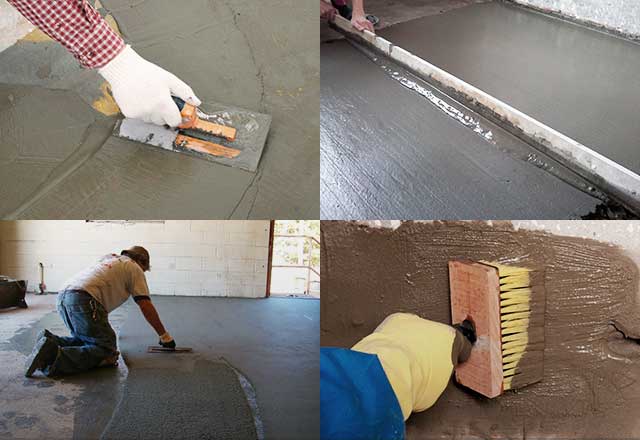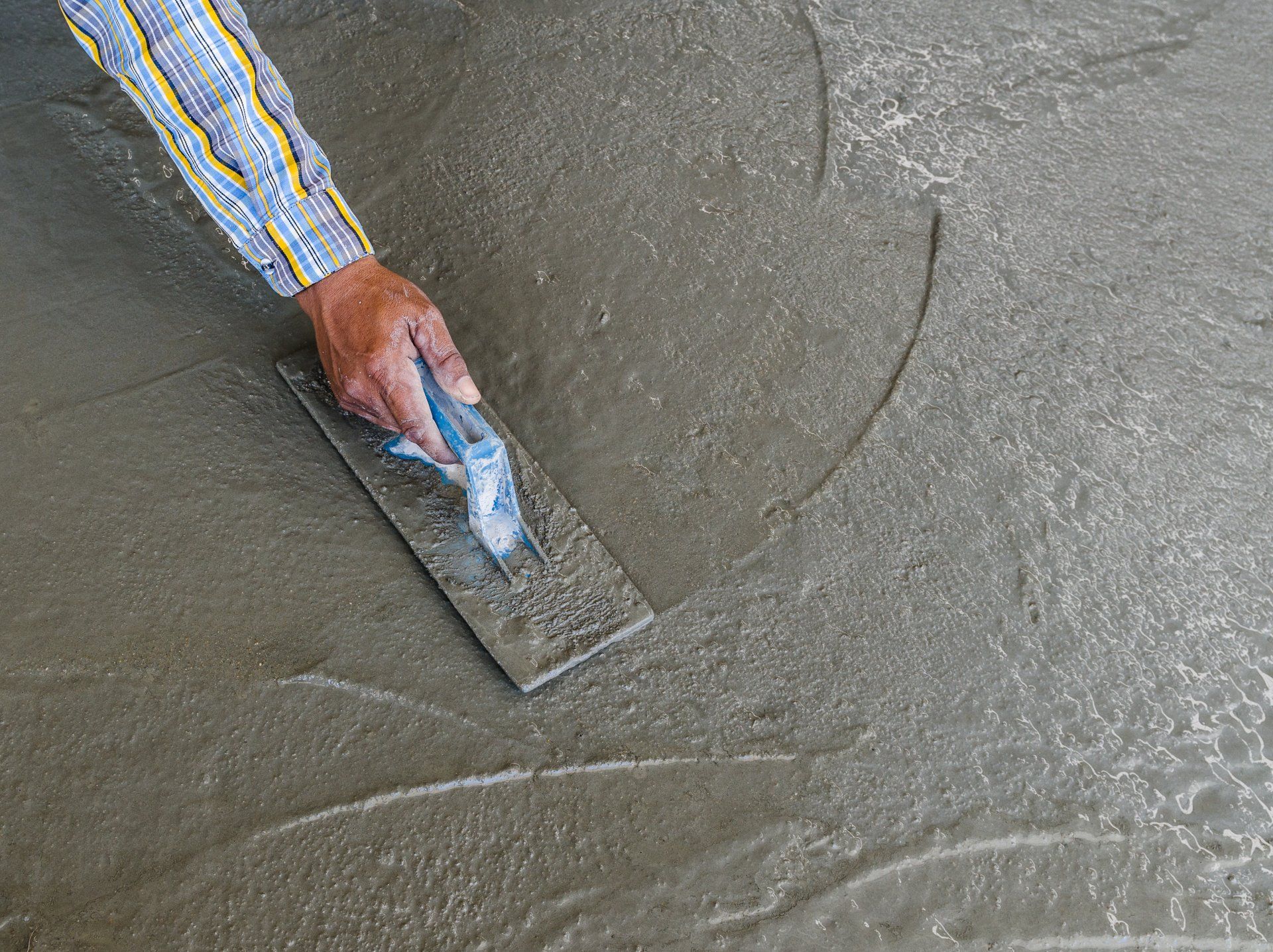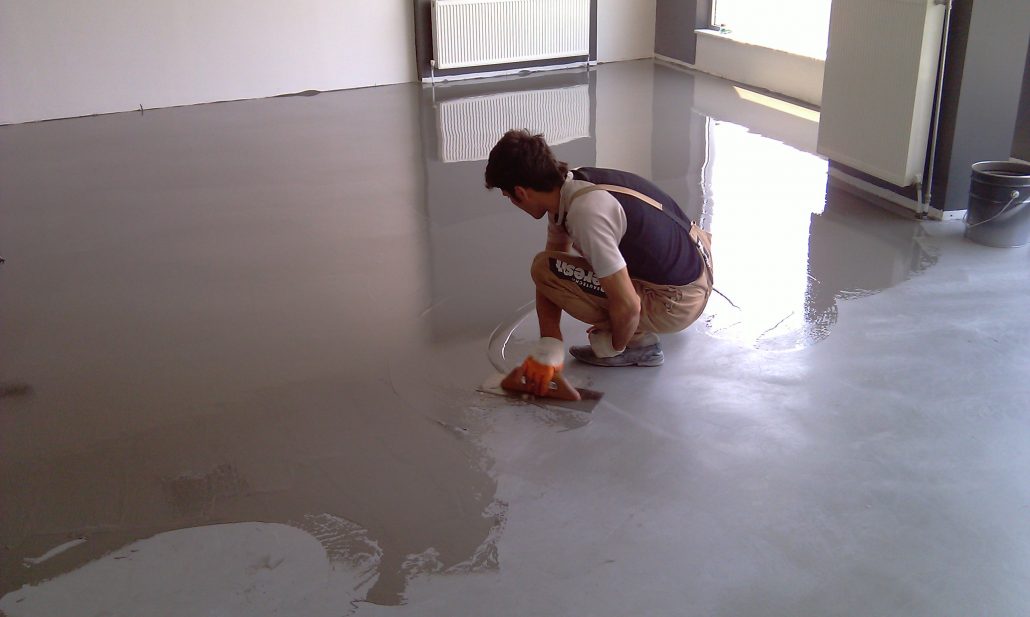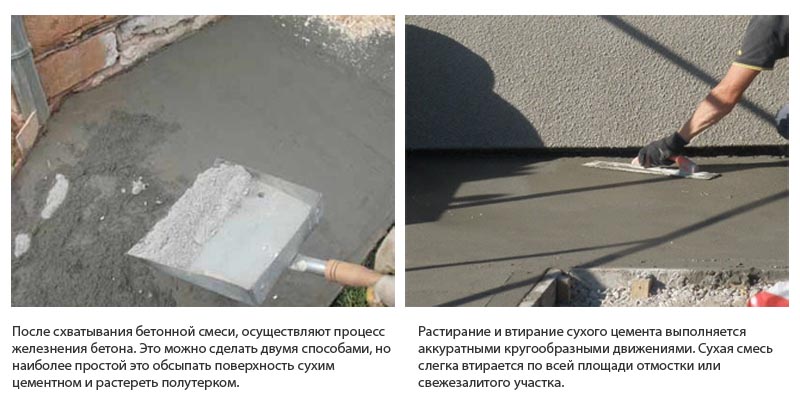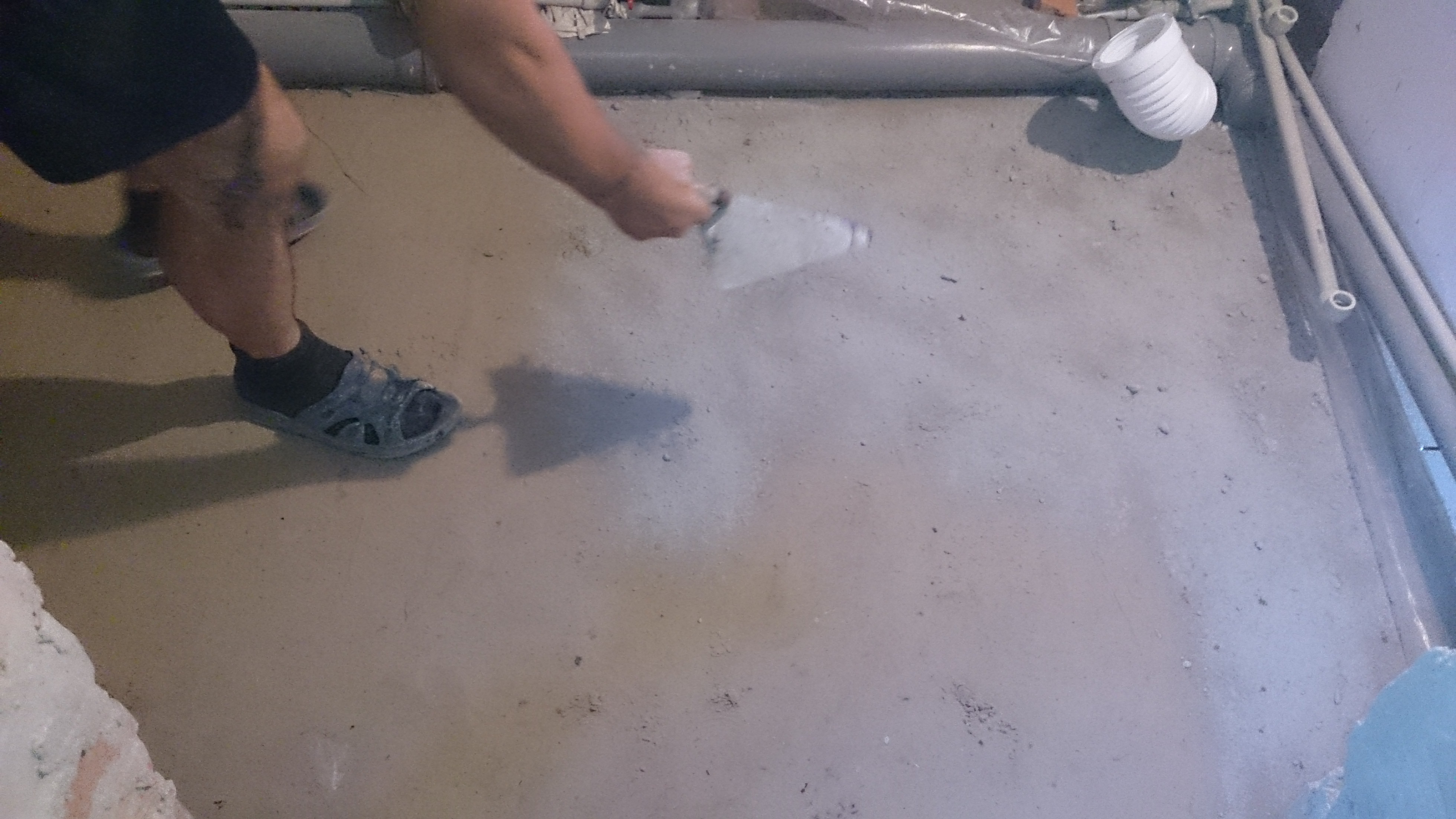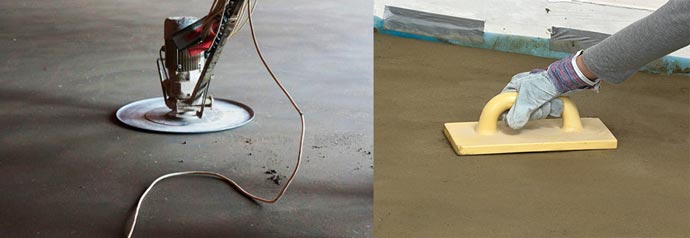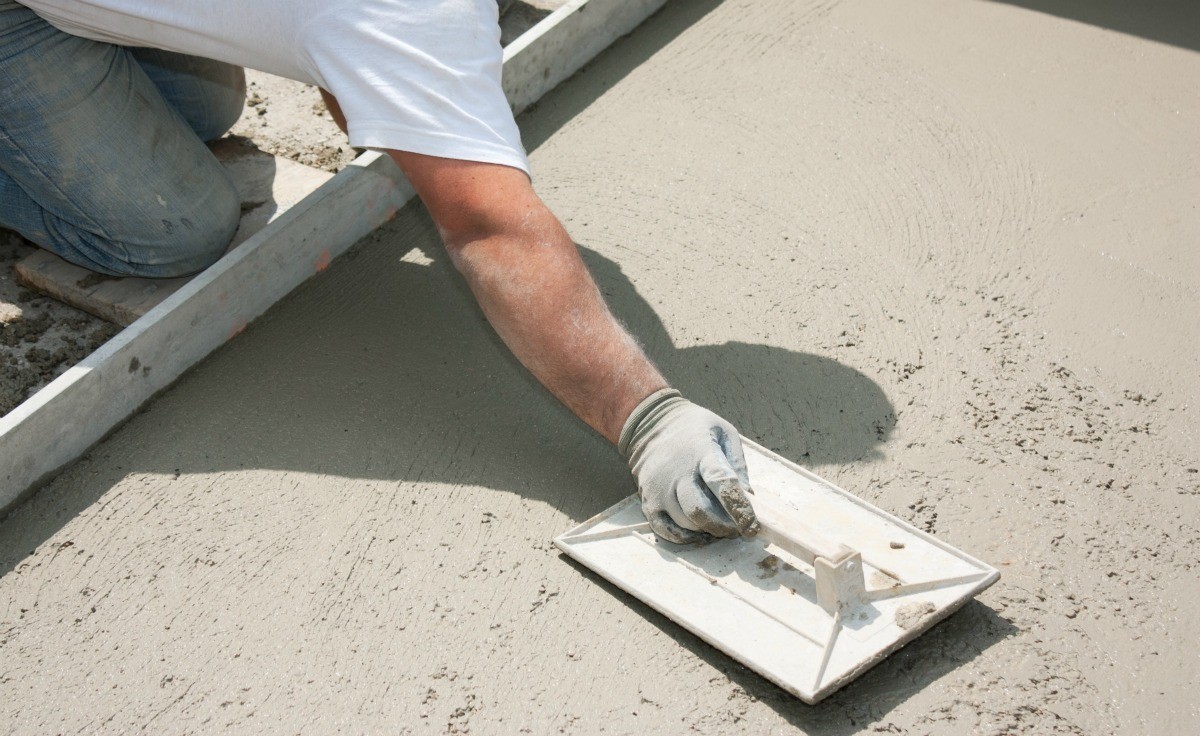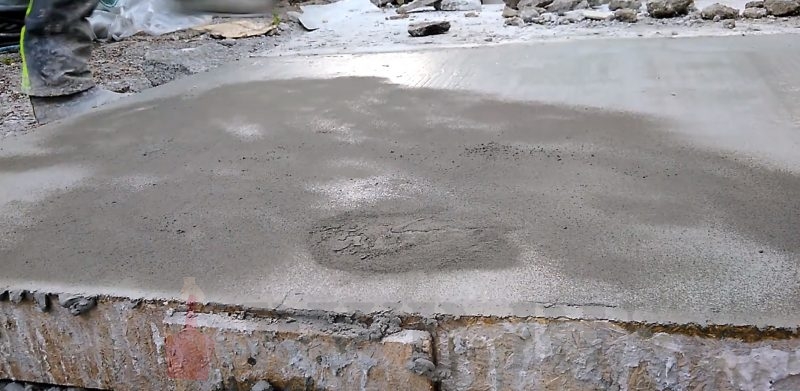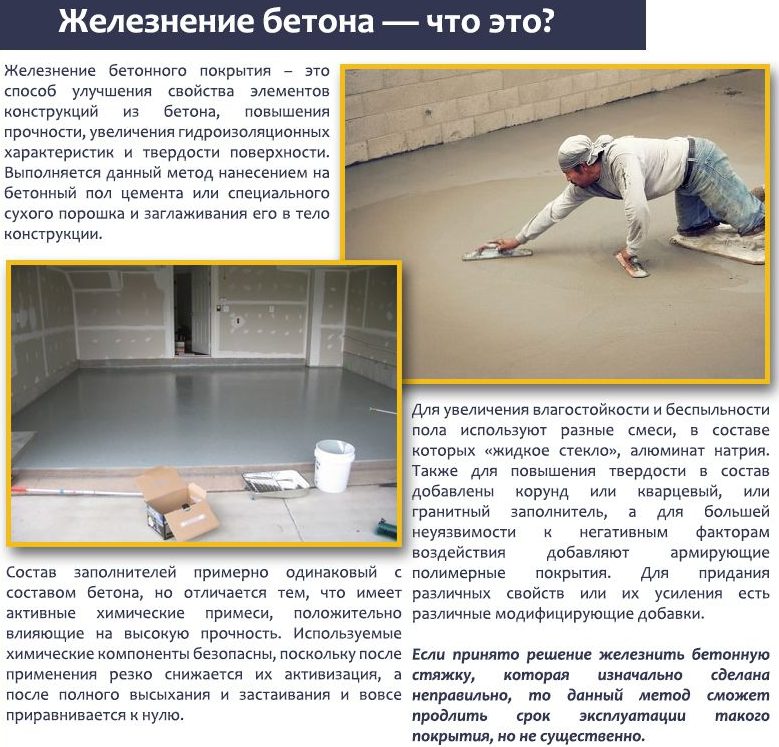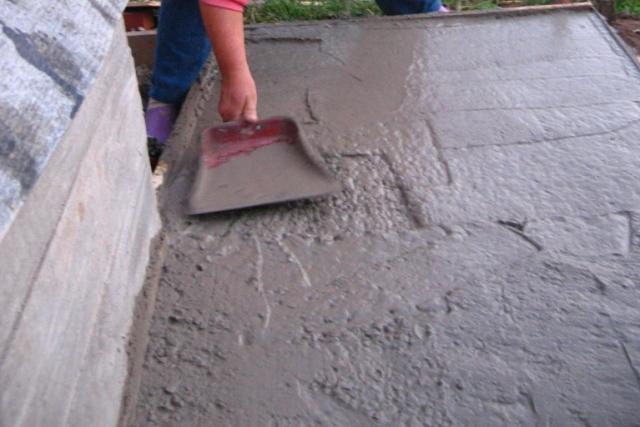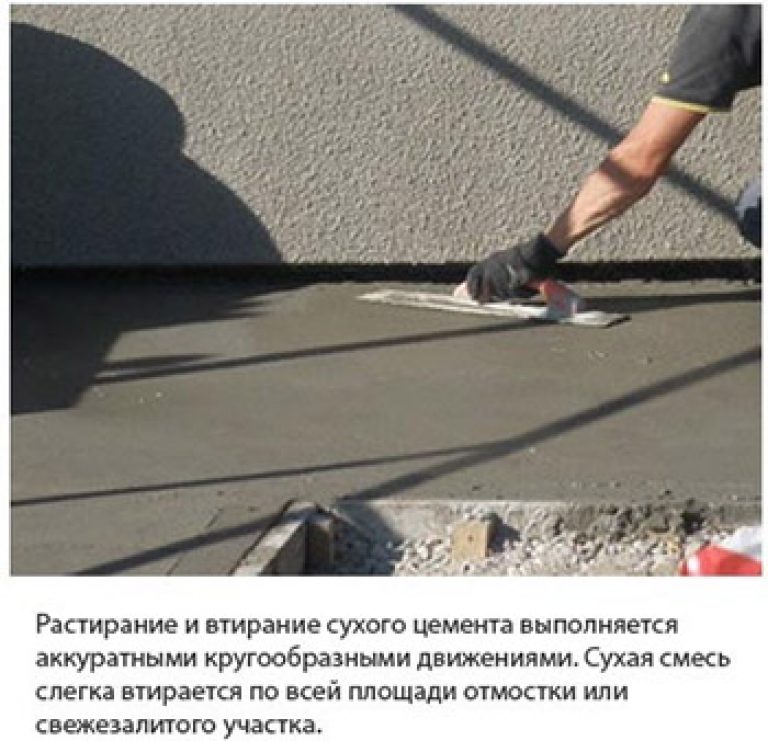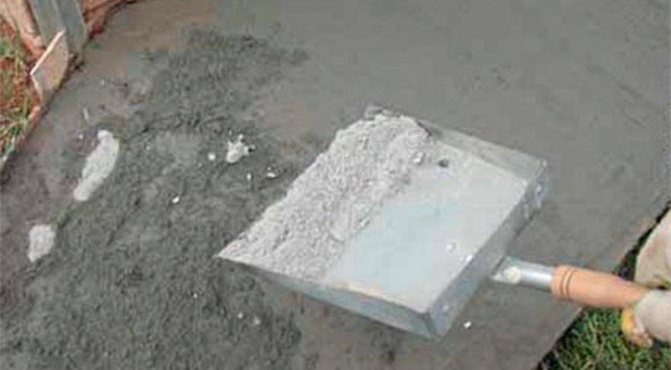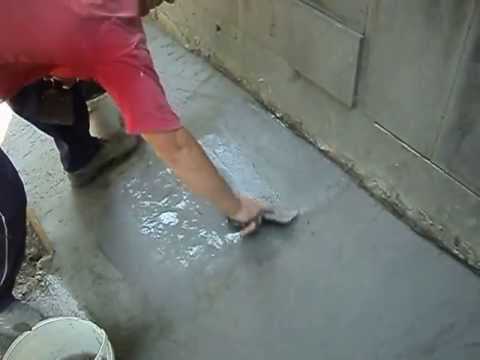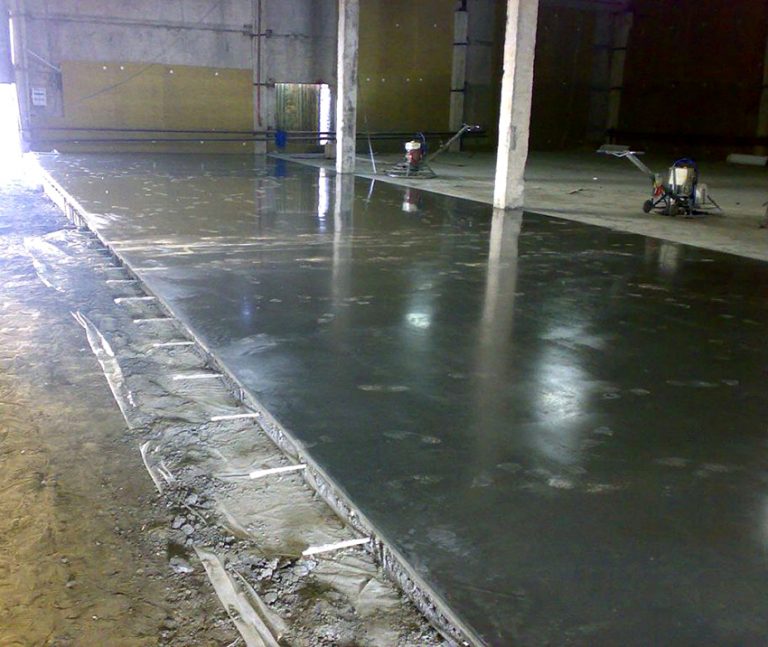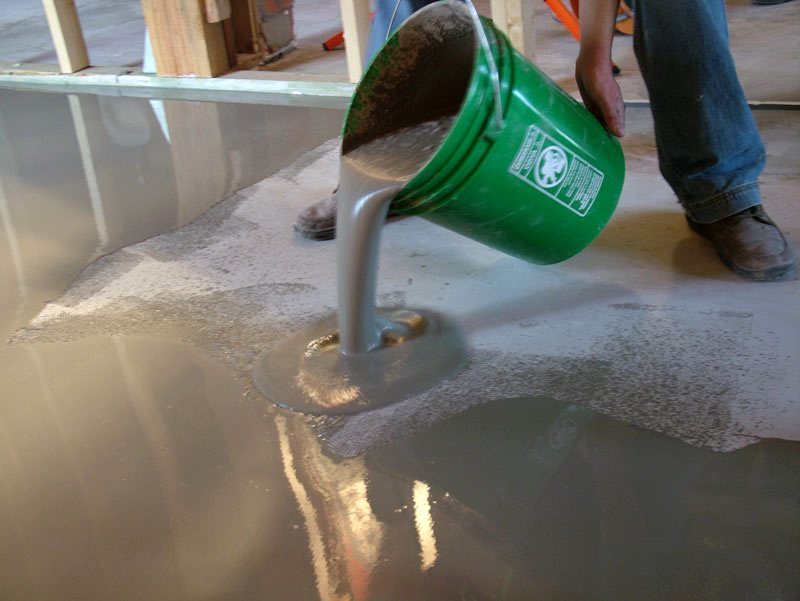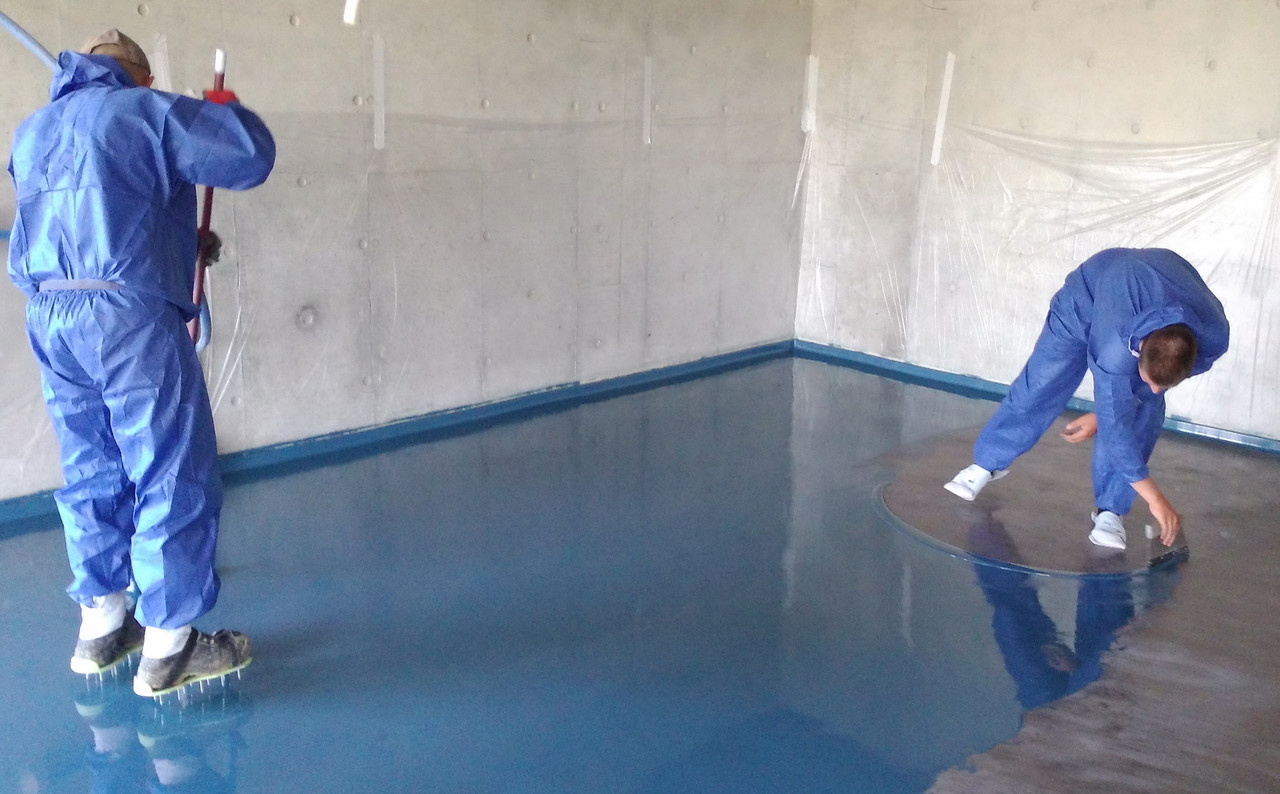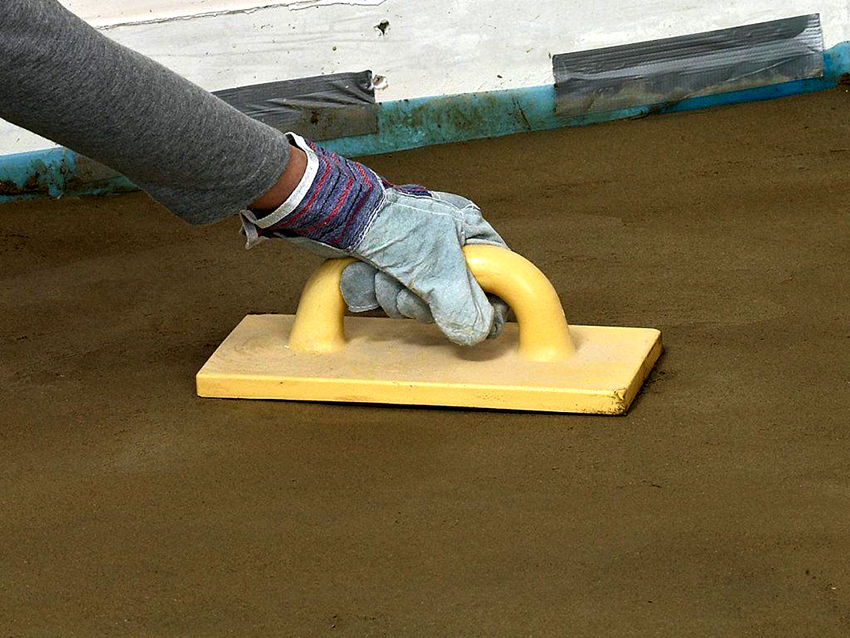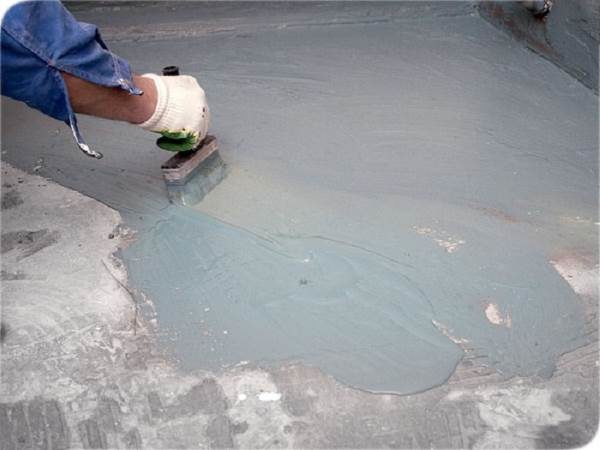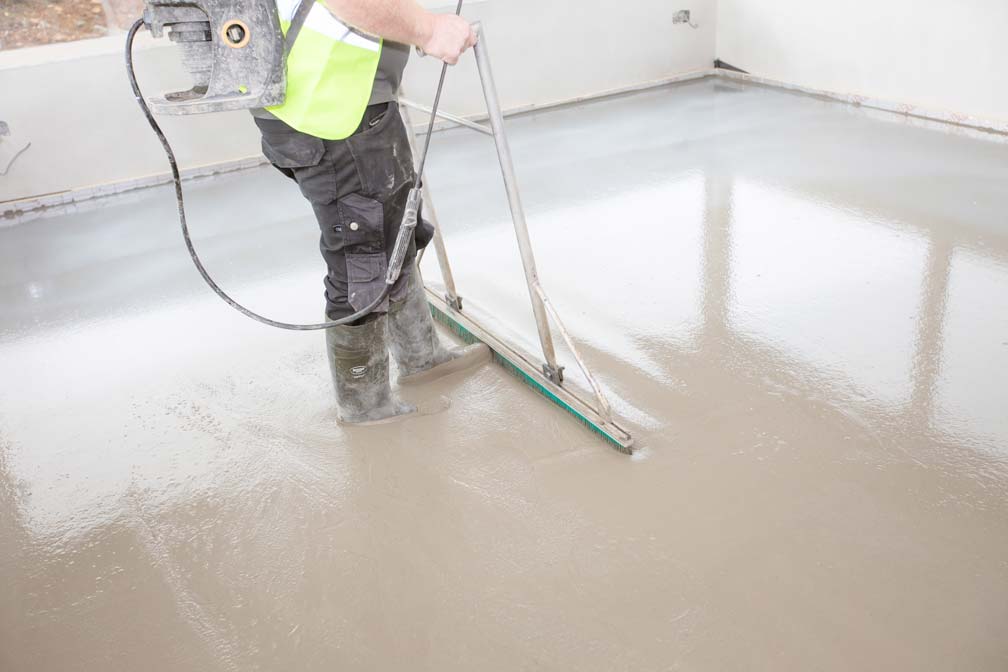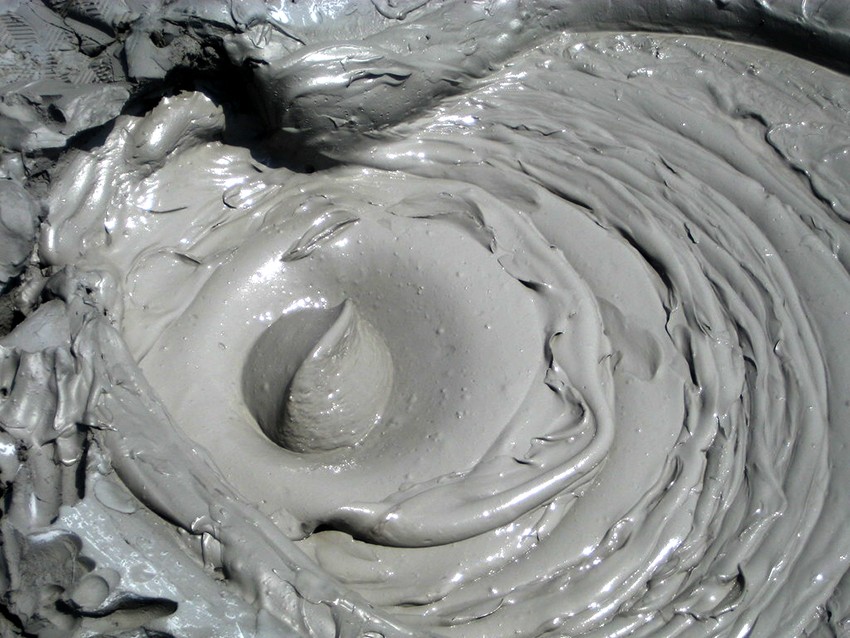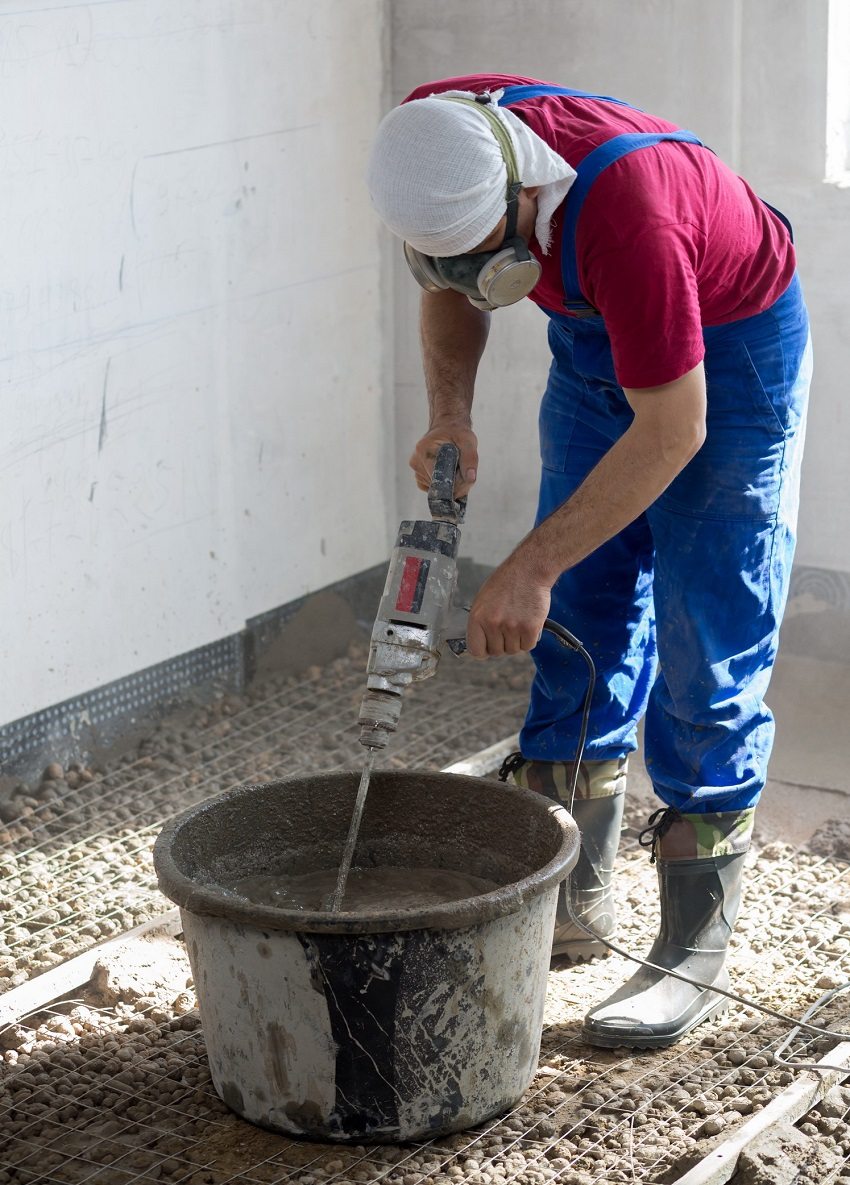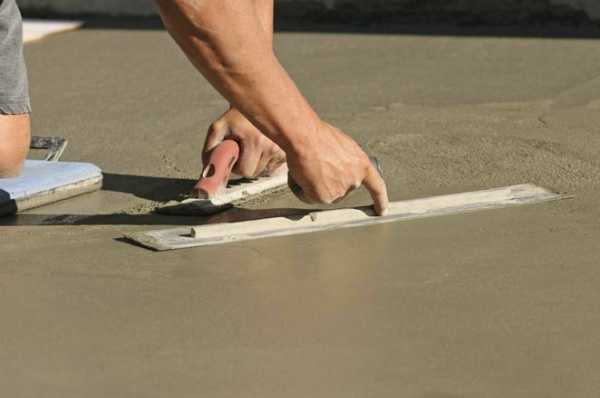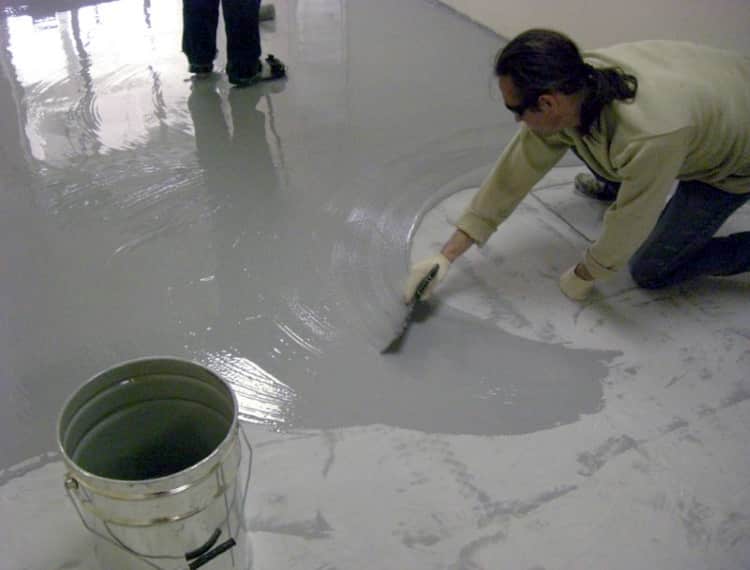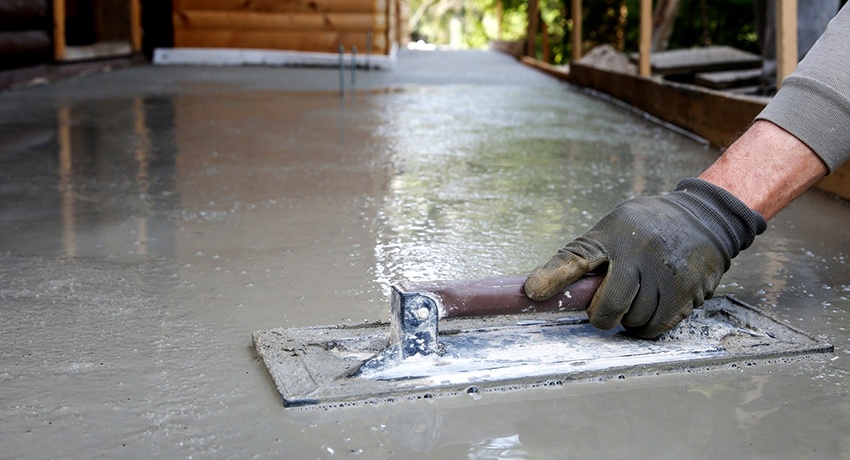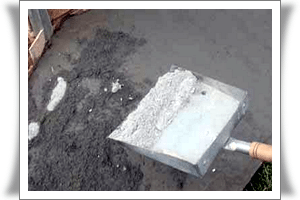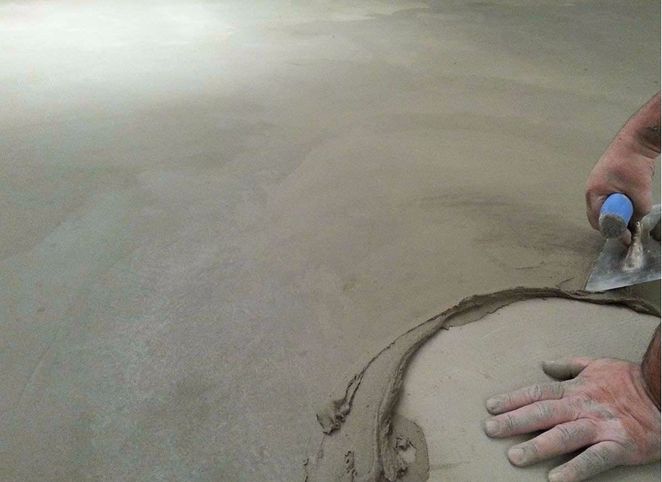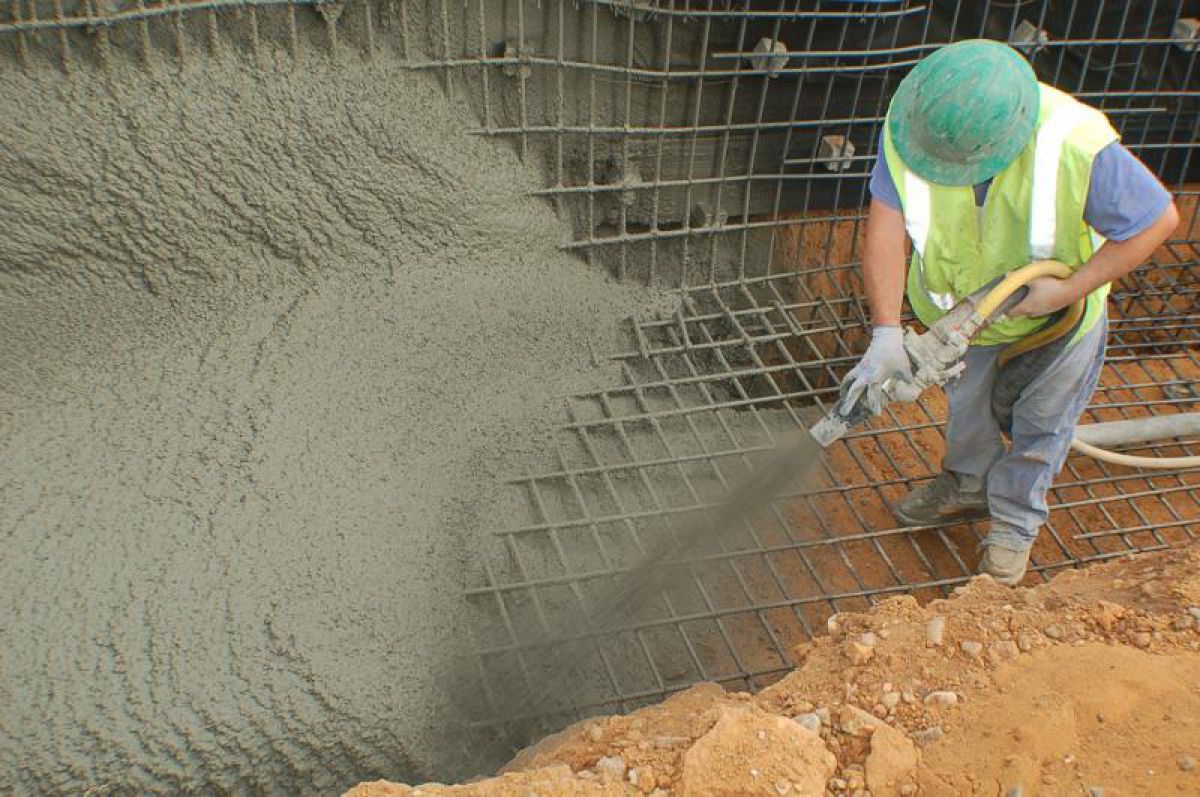How is the ironing of the concrete surface carried out
After the formation of the concrete layer under the influence of gravitational forces during hardening, heavy fillers slowly settle, which leads to the fact that the density of the upper layer decreases. This process has an extremely negative effect on the strength of the structure as a whole, so it should be prevented.

Before ironing, the concrete surface must be thoroughly cleaned.
Concrete is strengthened using a special technology, which includes several mandatory manipulations:
- thorough cleaning of the treated surface from dirt;
- preparation of the composition (subject to all requirements and recommendations given by the manufacturer);
- application of the ready-made solution to the surface.
After carrying out the listed activities, it is required to give the concrete some time so that it completely solidifies. There is no need to rush here, because the strength of the finished surface will depend on this. Reinforcement of concrete surfaces can be done in two ways:
- Dry. A dry cement mixture is used as an adhesive layer, after which the surface is well leveled.
- Wet. For strengthening, a liquid composition based on cement, colloidal mass or polymers is prepared.

When preparing the composition, it is necessary to strictly adhere to the manufacturer's recommendations.
Methods for ironing concrete
Concrete preparation tools.
There are several ways to iron concrete that you can do yourself. The first of them is dry ironing of concrete. The process of work consists in the fact that a thin layer of dry mixture for ironing is poured onto the not yet solidified concrete surface, which can be purchased at any hardware store or simply replaced with dry cement. To facilitate the task, you can pour the mixture through a sieve, so that it will evenly cover the entire surface.
After applying the mixture, this layer must be compacted with a plastering trowel. The mixture poured onto the surface of the concrete will draw out and absorb excess liquid, thereby binding to the top layer of concrete. Thanks to this, after 2-3 days, the concrete flooring will become very durable. This method is perfect if you need to iron the concrete floor, and to perform this procedure on vertical surfaces, it is better to use the wet method.
This method is perfect when the concrete flooring has already hardened, since the concrete is wet-ironed no earlier than two weeks after the concrete is placed. To perform this type of work, you need to make a cement mortar, which consists of sand and cement in proportion 1: 1. In that liquid glass is also added to the solution or aluminate, or any other component that will improve these or those. After the mortar is prepared, it must be applied to the concrete surface in a thin, even layer.
Table of mixtures for ironing.
When working on a vertical surface, the mixture is applied using the spraying or rolling technique, after which it is leveled with a plastering trowel and constantly measured with a water level to avoid wall unevenness.
Another way to iron concrete is to use a special impregnation in the work. It is applied on a perfectly flat surface of concrete that has not yet completely hardened. Due to its properties, the impregnation penetrates into the concrete structure, filling the free space with polymer. This impregnation is ideal for outdoor use as it can withstand huge temperature fluctuations, protecting the concrete from cracks and excess moisture.
Impregnation in the form of a dry mixture is applied to a damp concrete surface, after which it is left to absorb moisture.After drying, an additional protective layer forms on the surface of the concrete, which is even more resistant to chemical and physical influences. A sander is used to improve the appearance of the surface. After such a surface treatment, it is not at all necessary to cover it with other special building materials.
Do-it-yourself concrete ironing
First you need to choose a composition for strengthening the concrete surface. For these purposes can be used:
- dry cement of high grades (M400, M500, as high as possible);
- cement-sand mortar, prepared in a 1: 1 ratio. To achieve the best effect, it is recommended to add 1/10 of the lime;
- cement diluted with water. The ratio of the components can be different, usually 1: 1, you need to get the consistency of a suspension or liquid paste;
- ready-made polymer solutions for wet ironing;
- dry mixtures of polymer powders.
Additional components will help to improve the quality of cement compositions:
- sodium aluminate,
- balsat,
- quartz,
- stainless steel,
- corundum.
These additives should be used according to the instructions, usually their amount does not exceed 1% of the dry matter weight.
To give the finished coating aesthetic properties, pigment can be added to the solution.
Dry iron
It is very easy to iron the concrete that has just been laid. This does not even require special surface preparation.
It is important to carry out the procedure before the concrete starts to set!
- Sift the cement. Its consumption will be about 5 kg / m 2, from which the total amount of material can be calculated.
- Pour dry cement evenly onto the laid concrete. If necessary, dry fine sand can be added to it in a 1: 1 ratio.
- After some time (30-60 minutes), the surface should be rubbed with a wide wooden float or spatula.
The essence of ironing the floor with a dry method is to saturate the cement with moisture from the concrete by the capillary method. So the surface quickly gains strength and becomes almost perfect up to gloss.
The advantage of the method is its simplicity and relatively low cost.
Wet iron
Wet ironing technology is carried out with ready-made cement mortar. Unlike the "dry" method, this one is suitable for treating surfaces of different ages. For freshly laid, it is necessary to withstand at least 2 weeks so that the concrete has time to gain 50-70% of the design strength.
Before processing, the surface must be cleaned of dirt and dust, it is recommended to carry out wet cleaning and priming for 1-2 layers.
Mortar preparation: mix 1 part of sand and 1 part of cement, mix with water until the consistency of a suspension. Slaked lime will improve the plasticity, its amount should not exceed 10% by weight of dry components.
How to iron a concrete floor using the "wet" method:
- The prepared base should be moistened with water to improve the adhesion of the mortar and concrete.
- Apply the solution with a shovel or trowel, immediately leveling the surface. The layer thickness must be sufficient to hide the concrete base.
The hardened surface is sanded when the cement gains 70% strength, that is, after 3-4 weeks, depending on the conditions. To consolidate the result, an additional coating is made with polymers, but a good study will allow you to get an already smooth floor.
Strengthening concrete with a liquid method is also possible for vertical surfaces. This is a kind of plastering with a greasy cement mortar. In the case of working with walls, the distribution is carried out with spatulas.
Dry and wet polymers
To increase the water resistance, strength and plasticity of the concrete coating with liquid glass is the best solution in cases where additional floor cladding is not expected. The solution is sold ready-made, packaged in buckets.Substrate preparation is the same as for "wet" ironing: cleaning, priming.
How to iron concrete with liquid glass:
- The solution is applied with a trowel with a thickness of 2-3 mm and spread, leveled.
- Some time after hardening (see instructions), the surface is rubbed.
In the same way, polymers similar to liquid glass are applied. The main thing is to carefully read the instructions: polymer composites differ not only in composition, but also in properties, therefore they behave differently when laying and curing.
Dry polymer powders are considered to be more economical than ready-made solutions. It is as easy to iron a concrete surface with them as when working with dry cement. The main condition is that the application should be carried out on a freshly laid screed that has not had time to dry (there should be moisture in the upper layers).
Pour the sifted powder in a thin layer and rub it according to the recommendations on the package. On sale you can find products of different brands: Hard, Alfapol, Buttermilk, Vetonit, Mapetop N and others. The difference in most cases lies in the price, the effect is similar.
Concrete ironing - how to add additional properties to the surface?
With wet cleaning, moisture penetrates the floor, as a result of which a loss of strength of the magnesian floor occurs. In such floors, organic fillers are often used, which, when humidity changes, cause surface cracking.
Technologyhardening(toppings)
This technology consists in pouring a dry concrete hardener (topping) into the top layer of concrete, followed by compaction with concrete finishing machines. Dry concrete hardener (topping) contains high-strength cement binder, mineral (quartz, corundum, carborundum) or metal fillers, polymer additives and plasticizers. Floors made using dry hardening mixes (toppings) have improved performance compared to concrete coatings hardened by other methods. With the right choice of materials, the service life of such coatings reaches 12 - 17 years.
The main advantages of surface hardened concrete industrial flooring are:
- significant reduction in dust formation;
- high wear and impact resistance;
- oil and petrol resistance;
- obtaining a ready-to-use coating in one working cycle;
- durability;
- decorative properties.
The use of concrete floors with a hardened top layer is limited for two main reasons: insufficient chemical resistance and dust formation. In some areas, such as high-tech electronics assembly shops or laboratories, even the smallest dust generation is unacceptable. In such rooms, polymer coatings are mainly used.
The technology of "iron" and hardening with toppings is similar to the process of covering an industrial concrete floor: the hardening mixture is rubbed into the surface layer of freshly smoothed concrete, as a result of which additional compaction of the upper layer of the concrete base occurs. The hardened layer and the base concrete form a single whole, since both coatings are carried out on the same type of binder. As a result of final grinding, the maximum closure of pores in the surface of the coating occurs and, accordingly, an increase in its frost resistance and strength.
Thanks to this technology, resistance to static and dynamic loads, wear resistance, shock resistance is increased, sparking can be minimized, and antistatic properties are given to the surface.
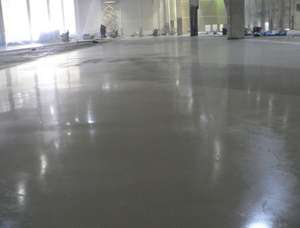 Precipitation, chemical and mechanical stress can destroy even the toughest materials. The concrete surface is no exception. Microcracks, flaking, peeling are a small amount of damage that can form under the influence of time.
Precipitation, chemical and mechanical stress can destroy even the toughest materials. The concrete surface is no exception. Microcracks, flaking, peeling are a small amount of damage that can form under the influence of time.
Various methods are used to strengthen the surface.One of the most popular and easy to implement is the iron method. It will help to strengthen the concrete floor, protect it from moisture penetration, and significantly increase the service life. In addition, it can be carried out independently, without the involvement of professional builders.
The essence of ironing consists in applying dry cement or other special mixture to a freshly prepared concrete surface, followed by rubbing.
Materials have been developed that increase not only the strength of the concrete surface, but also give it additional properties, for example, water resistance. In addition to the active components of the cement, the composition includes additional chemical additives that increase the resistance to abrasion and other active influences.
Various additives are added to the main component of all modern mixtures - Portland cement.
For ironing, metal fillers, polymer fibers, composite additives are used. The composition includes basalt, quartz sand, steel fiber, corundum, etc. You can find mixtures with pieces of stainless steel.
Chemical fillers often contain dyes. In the process of a chemical reaction with concrete components, the surface becomes decorative.
Ironing is also carried out using liquid compounds that can be easily found on the market. The substances contained in concrete enter into a chemical reaction, as a result of which a material is formed that fills all microcracks. Liquid formulations have deep penetration, which significantly increases surface strength.
Reasons to perform iron work
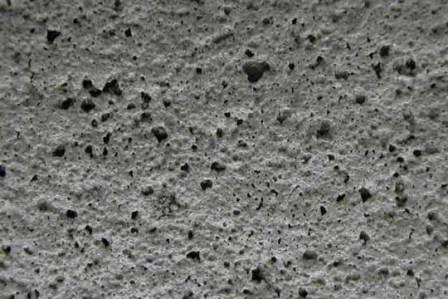
Concrete structure after ironing
It is no secret that solutions containing Portland cement have a porous structure. This is clearly noticeable if the cutting of reinforced concrete with diamond wheels was carried out.
The presence of pores is a negative quality, due to which the degree of hydrophobicity of concrete structures and structures decreases. In addition, due to the presence of a porous structure, the surface of concrete bases is prone to abrasion and dust, which is unacceptable for rooms with high traffic.
There are many solutions available to strengthen concrete surfaces and prevent dust formation. But the most effective and easy-to-implement method is iron. Let's try to figure out how to properly iron concrete.
Features of screed strengthening
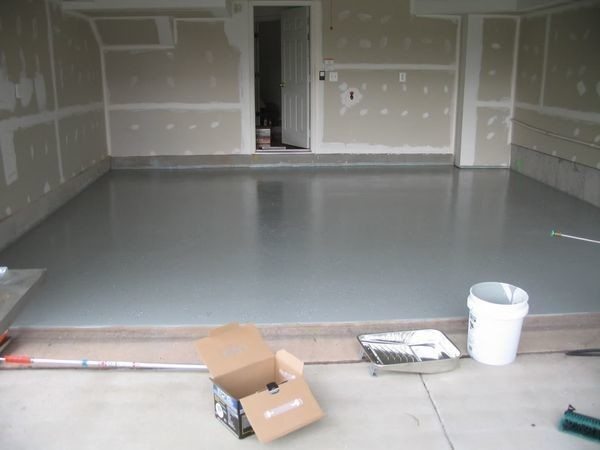
In the photo - a reinforced screed
Protecting the surface of a cement screed floor from excess moisture and abrasion is not as difficult as it might seem. The ironing instruction involves the application of a layer of dry cement or cement paste to a still fresh mortar. The applied layer should not exceed 3 mm in thickness. Immediately after application, the backfill layer is smoothed out with a plaster float or other devices.
The technology and the result of its application are characterized by a number of advantages, including:
- a significant increase in the strength and durability of the finished screed;
- resistance to negative environmental influences;
- ease of implementation;
- affordable price of the finished result in comparison with other methods of protective finishing.
Are there any drawbacks that should be paid attention to before starting work? Perhaps this is the case when there are no shortcomings and you can safely proceed to the protective treatment of the floor in the garage.
Iron mixtures
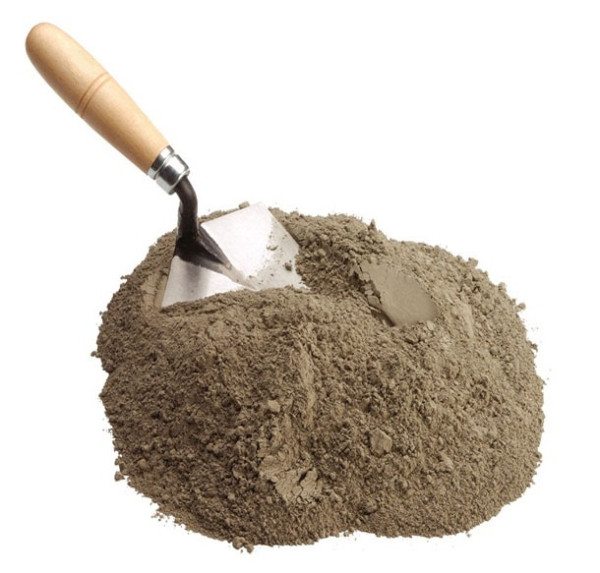
The correct selection of the ingredients for the mixture is the key to success!
If the question is how to iron the concrete floor in the garage, it's time to think about the composition of the mixture. Until recently, the strengthening of cement pavements was carried out using high-quality cement, which was sprinkled in a thin layer. Today, other more complex formulations are used that provide a better result.
A modern mixture for strengthening concrete is a fine powder, consisting of high-quality Portland cements and a number of fillers that provide increased hardness.
Among the fillers, granite or marble flour, ground quartz or corundum can be used. In addition, special modifying additives are introduced into industrially manufactured mixtures to regulate the rate of surface drying.
Screed strengthening process
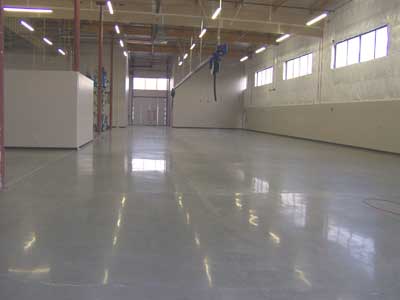
Concrete floor after ironing, grouting and polishing
As already mentioned, the ironing instruction involves the application of dry or semi-dry cement-containing mixtures to the freshly laid mortar with your own hands. To achieve the optimal parameters of dust-free and moisture resistance of the finished result, cement mortars are used with a number of modifying additives, such as water glass, sodium aluminate, etc.
In the event that the process of strengthening the solution is carried out correctly, you will get a flat and durable concrete surface, and neither primer nor deep penetration impregnation can provide such a result.
Depending on the method of implementation, there are two ways of ironing - dry and wet.
-
The dry method is only suitable for processing horizontal surfaces.
The simplest instruction for the implementation of this method involves the use of a sieve into which clean cement is poured. The cement is sieved with your own hands in order to exclude the presence of seals in the concrete. Then the sifted cement is evenly sprinkled onto the still damp surface in a layer not thicker than 3 mm.
Once on a semi-moist solution, the backfill will pull out the remaining moisture from the surface. As a result, the cement will become a dough, and the floor screed will acquire a hard crust. Then it remains to rub the resulting dough. -
The wet method is suitable for all surfaces. For these purposes, pre-sieved cement and other ingredients are kneaded into a thick mass. With this mass, slightly dried plaster is lubricated with a thin layer, which is then smoothed out with a plaster float until a clean and smooth surface is formed.
To to exclude cracking of the plaster, when ironing, you can use a dough made from Portland cement of the M300 brand and construction slaked lime. Both components must be sieved through a fine sieve. The proportions of the ingredients are 0.5 parts of cement to three parts of lime.
Let's take a closer look at how to iron a concrete screed.
The ways
In order to carry out this process, there are several ways: dry, wet ironing, the use of impregnations.
To carry out the work, you will need the following tools:
- trowel;
- graters or half graters;
- container for the preparation of a solution for the wet method;
- metal brush for cleaning old coatings;
- trowel.
Dry
This method is suitable if you decide to reinforce the concrete floor surface prior to building it or during the installation of the floor.
Dry ironing is only suitable for horizontal surfaces.
- after the concrete screed has set a little, this may take from 3 to 10 hours, a thin layer of cement is applied to it using a sieve. The thickness of such a layer should be within 2-3 mm;
- it should take some time until the cement is saturated with moisture, this will be evidenced by its darkening;
- using a trowel, cement is rubbed into the floor surface;
- when the floor dries, it must be periodically moistened for 3 days, and after a week it is covered with a polymer composition.
Some experts, when using the dry method, recommend not taking pure cement, but its mixture with sand in a 1: 1 ratio. You can walk on such a coating in a day, but it will acquire sufficient strength only after 3-4 days, and its final hardening occurs after 28 days.
Wet
The difference between this method and the previous one is that the floor is covered not with dry cement, but with a liquid mixture consisting of 1 part sand and 1 part cement... To prevent cracking, lime paste is added to the mortar in a ratio of 1:10 of the amount of cement.
The solution must be thoroughly mixed before use and applied to a damp concrete floor, after which it is trowelled. When the coating is completely hardened, it is covered with a polymer compound.
With the help of the wet ironing method, it is possible to harden not only horizontally, but also vertically located concrete surfaces.
Polyurethane impregnation
To harden the surface, you can use polyurethane impregnations, which are sold ready-made. Even a beginner can handle this job.
A polyurethane impregnation is applied to a clean concrete surface, which should be slightly damp, but already well cured. To distribute the impregnation,
you can use a trowel.
After the polyurethane impregnation hardens, a strong layer forms on the floor surface, while the specified material penetrates into the concrete for depth up to 5 mm.
Some home craftsmen carry out the ironing of concrete by adding liquid glass to the concrete, but experts say that this material is water-soluble and will gradually be washed out from the surface of the concrete floor, due to which its characteristics deteriorate. To improve the water-repellent properties of a concrete floor, it is best to use special polymer impregnations, which are inexpensive and can be purchased at any hardware store.
Adding liquid glass to the concrete in a ratio of 1:10 ensures a dust-free surface for a long period of its service.
Such impregnations can be applied even at negative temperatures, and in order to give the coating a certain shade, dyes of the corresponding color can be added to them.
Iron methods
The choice of method depends on the technological process:
- dry;
- wet;
- using polymers.
If the ironing is done immediately after pouring the blind area, we apply the dry method. This is the most reliable, simplest when compared to others. If the concrete has hardened, only the second or third can be used. They are suitable for restoring a strength film that has been destroyed.
Dry iron
The method is applied during the casting of the blind area. Wait at least two hours before processing so that the solution has time to settle. Water appears on the surface. Prepare a working mixture. High grade cement is required - 400 and above. If the cement has caked from long storage, it must be kneaded, sieved through a sieve. The mesh of the sieve is approximately 3 mm. If the cement is heavily caked, it will not work for ironing. It can be put on the foundation, masonry mortar.
 Dry method
Dry method
To reduce the consumption of the main component, sieved sand is added. The ratio is chosen 1: 1. You can add other ingredients, such as dye. A small layer of the mixture is poured onto a small surface of the blind area so that water is absorbed into it. Layer - about 3 mm
If there is not enough water, you can spray from a spray bottle, but be careful not to have a lot of water. It is better to do it before sprinkling, then the excess water can be removed
When a gruel is formed on the surface of the blind area, it is rubbed into the base, clogging the pores of the concrete with a trowel with a solid base. It should be smooth so as not to scratch blind area. A brief overview of the material described can be seen here:
Wet composition
Ironing is carried out after curing with concrete or on old surfaces. The maturation of concrete depends on the air temperature. From the above table, it can be seen that the higher the temperature, the faster the strength build-up occurs.
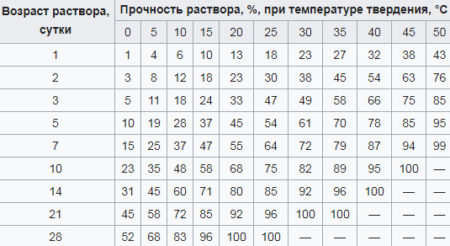 Effect of temperature on the rate of hardening
Effect of temperature on the rate of hardening
Filling must be done in warm weather.You can heat the monolith, there are different ways, but this is additional work, a waste of funds. Concrete "loves" moisture, a humid environment is required. This can be done, for example, by covering the surface with a film. Some are sprinkled with sawdust, covered with a cloth, and sprinkled with water. The result is a heat-insulating layer that reduces the temperature of the concrete.
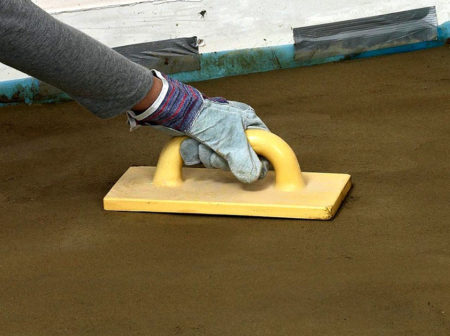 Rubbed with a grater
Rubbed with a grater
The cement mixture is produced similarly to the previous method, mixed with water separately, this simplifies the preparation of the mortar. To reduce the amount of water, 10% of the total volume of lime dough is added to the mixture - the solution turns out to be plastic, less prone to cracking. It is necessary to ensure that the blind area is clean of debris, greasy stains, since the solution will not adhere to the surface. If there is a concern that the surface is not clean enough, it is better to treat it with a primer.
Ironing with polymer compounds
In addition to cement mortars, you can use polymers:
- dry;
- liquid.
A popular dry material is polyurethane. It is applied on a damp concrete surface in a layer of 2-3 mm, evenly triturated over the base with a float. The mixture penetrates the concrete and clogs the pores. The treated surface is durable, moisture resistant.
 Polymer treatment
Polymer treatment
Of liquid mixtures, liquid glass is widespread. It can be added to the cement mix, or separately. Apply to fully cured, cleaned substrate. After drying, it can be polished, the base becomes shiny.
Dry ironing of concrete
Suitable only for horizontal surfaces, cannot be carried out on vertical, curved, inclined surfaces. In dry, fresh concrete, which did not have time to gain strength, is ironed. The method is simple, but, if the conditions of use are met, it is quite effective. Dry ironing assumes that the concrete solution is allowed to settle and grab. The main thing is that he does not have time to gain strength. The setting time depends on the type of concrete to be poured. For some it is higher, while for others it is lower. On average, it takes about twelve hours. It is necessary to take into account not only information regarding the grade of concrete, but also external factors. The higher the temperature, the faster the composition sets. Humidity, on the other hand, slows down this process. Access to direct sunlight plays an important role. The blind area always dries faster than the concrete floor in the garage.
Step-by-step instruction
When the laid concrete mixture has set, proceed to direct dry ironing:
- A three-millimeter layer of dry cement is applied to the surface. It is best to apply it with a sieve. This will eliminate the likelihood of large foreign particles entering. The layer must be distributed as evenly as possible. You can level the bulk material with a trowel.
- Leave the concrete surface for a while, so that the cement has time to absorb moisture from the concrete solution. If the surface is already very dry, you can pour a small amount of water on top. This usually happens in the summer, when the heat is intense.
- Direct grouting is started. The cement soaked in moisture is rubbed into the concrete surface until it becomes smooth and even. Movements should be circular. The coating is left to harden and gain strength for up to three to four days.
Ironing is considered complete, but at the end the surface can be primed, varnished or polymer composition.
Self-finishing concrete surfaces
Concrete floor grinding.
Often, the homeowner plans to protect the fence, facade or structural elements of his home from moisture. Why not implement it yourself, especially since the price of materials is minimal.
Here are some helpful tips for reworking concrete.
- After laying the concrete layers, without waiting for complete hardening, grout with cement paste with simultaneous compaction.Such plaster will form a single whole with the main structure, and will not fall off over time. The base will acquire moisture-proof properties and an attractive appearance.
- A high-quality homemade composition is not difficult to make. Mix the dry mortar with the plaster mixture in a 1/1 ratio. The mass is applied and rubbed with a trowel.
- You can prevent the plaster from cracking by adding a little lime dough to it. It is done like this: 1 part of cement grade 300, 3 parts of sifted fine sand, ½ part of lime dough.
- An iron plaster layer on horizontal substrates is made by applying a thin layer of dry cement to a slightly hardened mortar. After waiting until it is saturated with moisture, rub the mash into the surface with a paint float. Moisten the areas that are not sufficiently wet by sprinkling with water.




